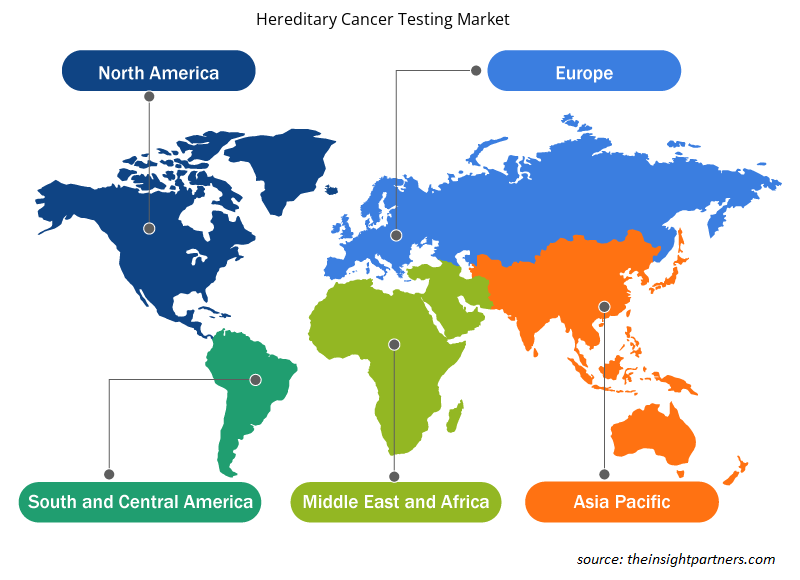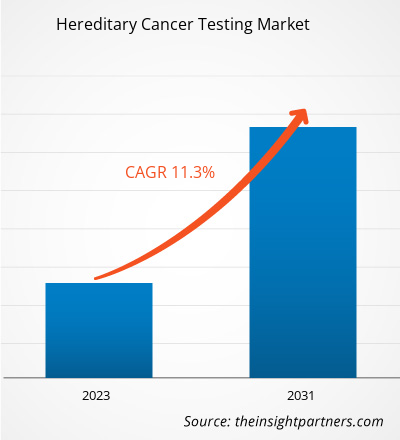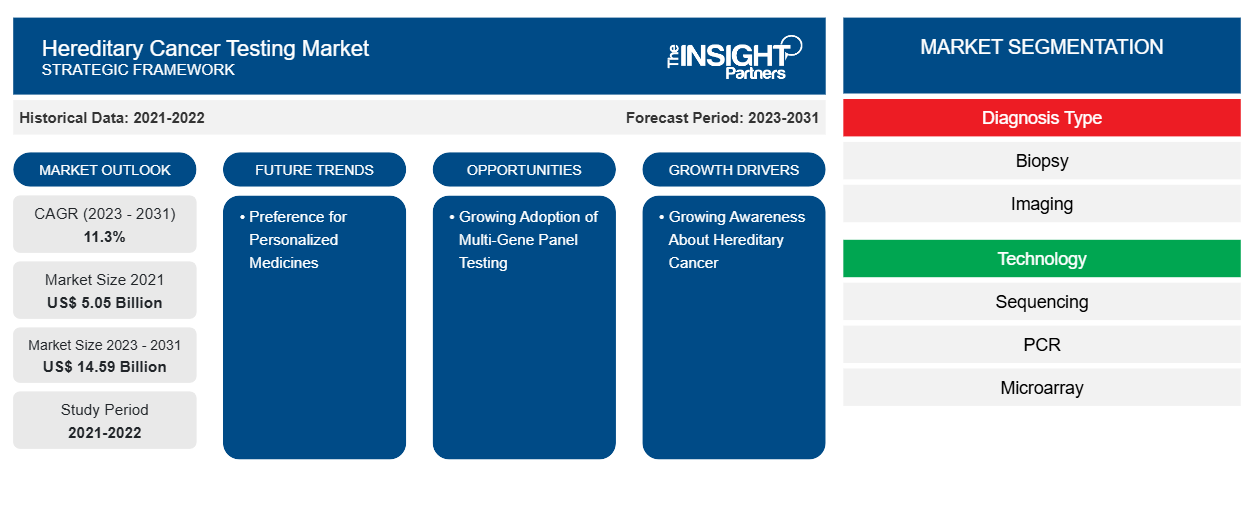遗传性癌症检测市场规模预计在 2021 年为 50.5 亿美元,在 2023 年为 XX 亿美元,预计到 2031 年将达到 145.9 亿美元;预计 2023-2031 年的复合年增长率为 11.3%。遗传性癌症患病率的增加和对遗传性癌症认识的提高是驱动因素。对个性化药物的偏好可能仍将是遗传性癌症检测市场趋势的关键。
遗传性癌症检测市场分析
癌症是一种遗传性疾病,由控制细胞功能的基因发生特定变异引起,尤其影响细胞生长和复制。5-10% 的癌症是由遗传性基因突变引起的。研究人员发现,特定基因的突变与 50 多种影响患上某些癌症的个体的遗传性癌症综合征有关。此外,约 5-10% 的乳腺癌与从父母那里遗传的突变基因有关。BRCA1 和 BRCA2 基因的变异很普遍。BRCA1 突变的女性一生患乳腺癌的风险约为 72%,而 BRCA2 突变的女性患乳腺癌的风险约为 69%。
遗传性癌症检测市场概况
亚太地区是遗传性癌症检测增长最快的市场。由于韩国等国家的政府支持提高癌症意识和其他举措,该地区遗传性癌症检测市场参与者的潜力巨大。中国对基因测序的需求正在增长,这主要是由于该国中产阶级的增加、老年人口的增加以及医疗保健系统的完善。根据世界卫生组织的数据,中国政府已经实施了“健康中国 2030”计划,这对其人口大有裨益。
定制此报告以满足您的需求
您可以免费定制任何报告,包括本报告的部分内容、国家级分析、Excel 数据包,以及为初创企业和大学提供优惠和折扣
-
获取此报告的关键市场趋势。这个免费样品将包括数据分析,从市场趋势到估计和预测。
遗传性癌症检测市场驱动因素和机遇
对遗传性癌症的认识不断提高
由于政府做出的各种努力,人们对遗传性癌症状况的认识正在不断提高。在过去十年中,公共医疗、卫生和科学界已投入大量资金来传播有关遗传性癌症状况的认识,主要关注遗传性癌症风险、家族史和遗传性癌症责任的基因检测。此外,制造商正专注于采用产品发布和批准、研发投资、政府资助和合作伙伴关系等策略,为全球患者提供便捷的获取途径。例如,2024 年 4 月,Ambry 启动了跨组织癌症遗传学临床证据联盟 (INTERACT) 合作,以促进遗传性癌症检测,旨在增加获得专门基因检测的机会。
多基因组合检测的普及——一个机遇
多基因面板无需针对不同癌症或变异类型进行多次检测。拷贝数变异 (CNV) 是遗传变异的常见来源,与许多遗传疾病有关。它也是遗传性癌症诊断的重要组成部分。
英国政府和 Genomic England 表示,现在所有 CNV 分析都将通过 NGS 而不是多重连接依赖性探针扩增 (MLPA) 进行。由于其优势,所有实验室流程都将简化,并能够使用单一工作流程和分析流程检测所有 SNV、INDEL 和 CNV 变体。
北美、欧洲和亚洲各国将会增加多基因组合检测的采用。
遗传性癌症检测市场报告细分分析
有助于得出遗传性癌症检测市场分析的关键部分是产品诊断类型、技术和最终用户。
- 根据诊断类型,遗传性癌症检测市场分为活检和成像。活检部分在 2023 年占据了最大的市场份额。然而,预计成像部分在预测期内的复合年增长率最高。
- 根据技术,遗传性癌症检测市场分为测序、PCR 和微阵列。测序部分在 2023 年占据最大的市场份额,预计同一部分在预测期内将实现最高的复合年增长率。
- 根据最终用户,遗传性癌症检测市场分为诊断中心、医院和诊所。医院部门在 2023 年占据了最大的市场份额。此外,预计同一部门在预测期内将在市场上实现最高的复合年增长率。
遗传性癌症检测市场份额按地区分析
遗传性癌症检测市场报告的地理范围主要分为五个地区:北美、亚太地区、欧洲、中东和非洲、南美/南美和中美洲。
北美遗传性癌症检测市场分为美国、加拿大和墨西哥。2023 年,美国占据北美遗传性癌症检测市场的最大份额。近年来,美国和加拿大人口中癌症患者数量的增加、政府资金的增加以及遗传性疾病发病率的上升推动了北美遗传性癌症检测市场的预期增长。政府还采取措施提高民众对癌症的认识。例如,美国临床肿瘤学会 (ASCO) 开设了一门关于癌症认识的课程,以传播有关这种疾病的完整和基本知识,包括遗传性癌症遗传学。
遗传性癌症检测市场区域洞察
Insight Partners 的分析师已详细解释了预测期内影响遗传性癌症检测市场的区域趋势和因素。本节还讨论了北美、欧洲、亚太地区、中东和非洲以及南美和中美洲的遗传性癌症检测市场细分和地理位置。

- 获取遗传性癌症检测市场的区域特定数据
遗传性癌症检测市场报告范围
| 报告属性 | 细节 |
|---|---|
| 2021 年市场规模 | 50.5亿美元 |
| 2031 年市场规模 | 145.9亿美元 |
| 全球复合年增长率(2023 - 2031) | 11.3% |
| 史料 | 2021-2022 |
| 预测期 | 2023-2031 |
| 涵盖的领域 |
按诊断类型
|
| 覆盖地区和国家 |
北美
|
| 市场领导者和主要公司简介 |
|
遗传性癌症检测市场参与者密度:了解其对业务动态的影响
遗传性癌症检测市场正在快速增长,这得益于终端用户需求的不断增长,而这些需求又源于消费者偏好的不断变化、技术进步以及对产品优势的认识不断提高等因素。随着需求的增加,企业正在扩大其产品范围,进行创新以满足消费者的需求,并利用新兴趋势,从而进一步推动市场增长。
市场参与者密度是指在特定市场或行业内运营的企业或公司的分布情况。它表明在给定市场空间中,相对于其规模或总市场价值,有多少竞争对手(市场参与者)存在。
在遗传性癌症检测市场运营的主要公司有:
- Hologic 公司
- 荷兰皇家飞利浦公司
- Quest Diagnostics 公司
- Myriad Genetics 公司
- 癌症遗传学公司
- 英维泰公司
免责声明:上面列出的公司没有按照任何特定顺序排列。

- 了解遗传性癌症检测市场顶级关键参与者概况
遗传性癌症检测市场新闻和最新发展
遗传性癌症检测市场通过收集来自一级和二级研究的定性和定量数据进行评估,其中包括重要的公司出版物、协会数据和数据库。以下是遗传性癌症检测市场的发展列表:
- Exact Sciences Corp. 宣布在美国推出 Riskguard 遗传性癌症检测。该检测使用简单的血液或唾液样本,针对 10 种常见癌症(包括结直肠癌、子宫内膜癌、胃癌、胰腺癌、乳腺癌、前列腺癌、皮肤癌、卵巢癌、肾癌和内分泌癌)提供个性化患者报告,其中包括基因特异性和家族性风险。(Exact Sciences Corp/新闻稿,2024 年 2 月)
- Devyser 宣布推出两款新产品,Devyser LynchFAP 和 Devyser BRCA PALB2。这些试剂盒可高效、有针对性且自信地分析与癌症风险增加相关的基因。Devyser LynchFAP 提供全面的解决方案来分析 PMS2 和其他 9 种与遗传性结直肠癌综合征相关的基因(来源:Devyser,新闻稿,2023 年 6 月)
遗传性癌症检测市场报告覆盖范围和交付成果
“遗传性癌症检测市场规模和预测(2021-2031)”报告对以下领域进行了详细的市场分析:
- 范围内涵盖的所有主要细分市场的全球、区域和国家层面的市场规模和预测
- 市场动态,如驱动因素、限制因素和关键机遇
- 未来主要趋势
- 详细的 PEST/波特五力分析和 SWOT 分析
- 全球和区域市场分析涵盖关键市场趋势、主要参与者、法规和最新市场发展
- 行业格局和竞争分析,涵盖市场集中度、热点图分析、知名参与者和最新发展
- 详细的公司简介
- 历史分析(2 年)、基准年、预测(7 年)及复合年增长率
- PEST和SWOT分析
- 市场规模、价值/数量 - 全球、区域、国家
- 行业和竞争格局
- Excel 数据集
近期报告
相关报告
客户评价
购买理由
- 明智的决策
- 了解市场动态
- 竞争分析
- 客户洞察
- 市场预测
- 风险规避
- 战略规划
- 投资论证
- 识别新兴市场
- 优化营销策略
- 提升运营效率
- 顺应监管趋势























 获取免费样品 - 遗传性癌症检测市场
获取免费样品 - 遗传性癌症检测市场